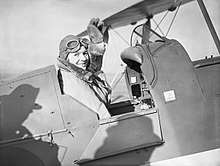Pauline Gower
| Pauline Gower | |
|---|---|
 Pauline Gower at a Women's Engineering Society awards dinner in the 1940s | |
| Born |
Pauline Mary de Peauly Gower 22 July 1910 Tonbridge, Kent, England |
| Died |
2 March 1947 (aged 36)[1] Royal Tunbridge Wells, Kent, England |
| Nationality | British |
| Occupation | Pilot |
| Spouse(s) |
William Cusack Fahie (m. 1945) |
| Parent(s) |
|
Pauline Mary de Peauly Gower Fahie (22 July 1910 – 2 March 1947) was a British pilot and writer who established the women's branch of the Air Transport Auxiliary during the Second World War.
Early life and education
Daughter of MP Sir Robert Gower, and educated at Beechwood Sacred Heart School, she first flew with Alan Cobham and was fascinated by flying. Gower met Dorothy Spicer at the London Aeroplane Club at Stag Lane Aerodrome[2] and they became friends. In August 1931 they established a joy-riding and air taxi service in Kent.[3] Gower was licensed to carry passengers for 'hire or reward', and Spicer was qualified as a ground engineer and held an 'A' (private) pilot's licence. They hired a plane and later bought a Gypsy Moth for the business, but struggled to make a living so decided to join the Crimson Fleet air circus and later the British Hospitals' air pageant.
In 1932, to support British Hospitals, they toured the country with an Air Circus, giving air pageants in 200 towns.[4] They joined the Aeronautical Section of the Women's Engineering Society in 1932.[5] Gower also wrote for Girl's Own Paper and Chatterbox and published a collection of poetry, Piffling Poems for Pilots, in 1934. As a writer she was acquainted with W. E. Johns whose character Worrals was based on herself as well as Amy Johnson.
Engineering work

In 1935 she was appointed as a council member for the Women's Engineering Society.[6] She chaired a meeting on "The History of British Airships", where Mr. M. Langley championed the airboat and Hon. A. F. de Moleyns the airship.[7] In 1936, Gower was the first woman to be awarded the Air Ministry's Second Class Navigator's Licence.[8] Later that year, Gower and her colleague Dorothy Spicer ('daring aeronauts') presented a technical paper at the Women's Engineering Society Annual General Meeting on the treatment of metals for aircraft engineers. [9] In 1938, she was appointed a civil defence commissioner in London with the Civil Air Guard. That year her work on women in aviation—Women with Wings—was published.[10] On the outbreak of the Second World War, Gower made use of her high-level connections to propose the establishment of a women's section in the new Air Transport Auxiliary —the ATA would be responsible for ferrying military aircraft from factory or repair facility to storage unit or operational unit—to the authorities.

Gower was appointed as the head of the women's branch, and commenced the selection and testing of women pilots, the first eight being appointed by the ATA on 1 January 1940. Early members included ice-hockey international Mona Friedlander, Margaret Fairweather (Lord Runciman's daughter) and former ballet dancer Rona Rees.[11] Later members included Amy Johnson and former Olympic skier Lois Butler. Gower received the MBE for her services in 1942[1] and received a Harmon Trophy award posthumously in 1950.[12]
Personal life
Gower married Wing Commander Bill Fahie in 1945. She died in 1947 giving birth to twin sons, who survived.[1][13]
References
- 1 2 3 "Mrs. W. C. Fahie". The Times. The Times Digital Archive. 4 March 1947. p. 7.
- ↑ Fahie, Michael (2004-09-23). Spicer [married name Pearse], Dorothy Norman (1908–1946), aviator and aeronautical engineer. Oxford Dictionary of National Biography. Oxford University Press. doi:10.1093/ref:odnb/67672.
- ↑ ""Thirteenth Annual Report". The Woman Engineer. The Institution of Engineering and Technology. 3 (12): 189". October 1932.
- ↑ "The Women's Engineer (1929 - 1934)". theiet.org. 3. Retrieved 11 October 2016.
- ↑ ""News of Members". The Woman Engineer. The Institution of Engineering and Technology. 3 (15): 247". June 1933.
- ↑ "The Women Engineer". theiet.org. 4: 62–63. 1935. Retrieved 11 October 2016.
- ↑ "The Women's Engineer". theiet.org. 4: 94–95. 1935. Retrieved 11 October 2016.
- ↑ "The Women's Engineer". theiet.org. 4: 104–1055. 1935. Retrieved 11 October 2016.
- ↑ "The Women's Engineer". theiet.org. 4: 204–205. 1935. Retrieved 11 October 2016.
- ↑ Merry, Lois K. Women Military Pilots of World War II: A History with Biographies of American, British, Russian and German Aviators. Jefferson, North Carolina: McFarland & Company Inc., 2010. ISBN 978-0-7864-4441-0
- ↑ "ATA First Eight". www.airtransportaux.com. Retrieved 2016-10-28.
- ↑ "Mrs. W. C. Fahie". The Times (London, England). 4 March 1947. Retrieved 28 October 2016 – via Gale.
- ↑ Notice of Pauline Fahie's death, flightglobal.com, 13 March 1947.
Sources
- Curtis, Lettice, The Forgotten Pilots, Nelson Saunders, Olney, Bucks, 1985; ISBN 0-947750-02-9
- Edwards, Owen Dudley, "The Battle of Britain and Children's Literature" in Paul Addison & Jeremy A. Crang (eds), The Burning Blue: a new history of the Battle of Britain. London: Pimlico, 2000; ISBN 0-7126-6475-0
- Edwards, Owen Dudley, British Children's Fiction of the Second World War. Edinburgh: Edinburgh University Press, 2007; ISBN 0-7486-1651-9
- Fahie, Michael, A Harvest of Memories: The Life of Pauline Gower, MBE. Peterborough: GMS Enterprises, 1995; ISBN 1-870384-37-7
- Whittell, Giles, Spitfire Women of World War II. (Hardcover) November 2007 by Harper Press; ISBN 0007235356 ( ISBN 9780007235353)
External links
| Wikimedia Commons has media related to Pauline Gower. |
- Pauline Gower, Woman's Hour, bbc.co.uk, 20 August 2001
- Brief History of the ATA, motherflieshurricanes.com
- Women in aviation, airsceneuk.org.uk
- Portraits at the National Picture Gallery, npg.org.uk
- Aviation Pioneers: An Anthology, monash.edu.au
- Gower (married name Fahie), Pauline Mary de Peauly (1910–1947), aviator (by Michael Fahie) Oxford Dictionary of National Biography website